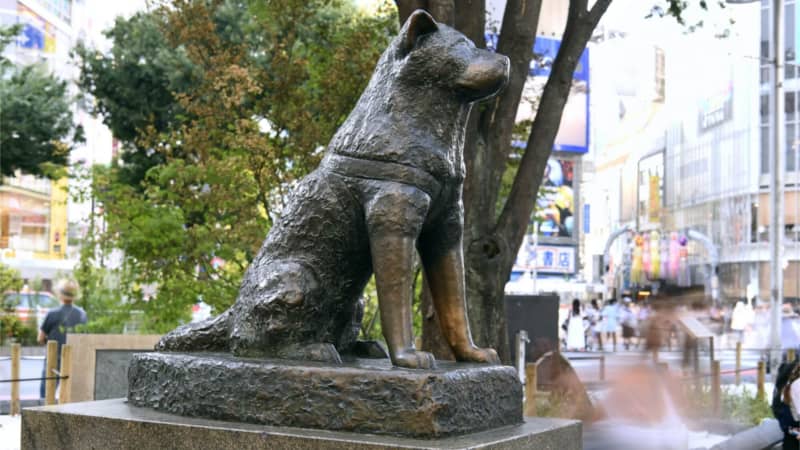One of the busiest pedestrian crossings in the world, Shibuya crossing is perhaps the most iconic symbol of the city of Tokyo around the world.
Shibuya Crossing’s large advertising screens and heavy foot traffic means it is often compared to the Times Square intersection in New York and Piccadilly Circus in London, and it is often seen as representative of the ultra-modern image of Tokyo projected worldwide.
The history of Shibuya Crossing dates back over 100 years to the construction of Shibuya Station in 1885. Originally only serving as a stop on the Shinagawa metro line, now known as the JR Yamanote Line, it has since expanded to serve over 8 different metro lines in Toyko.
Location and how to get there
Shibuya crossing is located in the very center of Tokyo, outside the Hachiko exit at Shibuya station.
It is easy to get to Shibuya station from almost anywhere in the city using the JR Pass on the major city loop, the JR Yamanote Line. The Keio Inokashira, Tokyu Den-en-toshi, Tokyu Toyoko, Tokyo Metro Ginza, Hanzomon, and Fukutoshin lines also all stop at Shibuya.

Hachikō statue
Shibuya Crossing has become synonymous with the bittersweet story of an Akita dog, Hachikō, who lived in the area in the 1920s. This famously loyal dog would accompany his owner, Professor Ueno, to Shibuya Station every day and wait there for the man to return from work, becoming a popular fixture around the crossing.
This continued for over a year, until one day the professor did not return, having passed away suddenly from a brain hemorrhage while at work. Nevertheless, Hachikō continued to wait for his owner, and, incredibly, would return to the same spot at Shibuya every day for the next 9 years.

When Hachikō’s loyalty came to the attention of one of the professor’s students, the dog’s incredible story came to the attention of the public at large, and a statue celebrating the canine’s spirit was erected outside Shibuya Station in 1934.
Hachikō, unfortunately, passed away the following year, but his legacy lives on in Japan and across the world, becoming the inspiration for the Richard Gere film A Dog’s Tale, released in 2009.
One of Tokyo’s top attractions
Shibuya Crossing is best known for the incredible ‘scamble’ that occurs every time the traffic lights turn red, stopping all vehicles in every direction to allow a huge wave of pedestrians to flood into the intersection for a few moments.
One of the most popular spots to watch this soothing flood of pedestrians is from the second story of the huge Starbucks located on the north side of the crossing, in the Tsutaya building. The floor-to-ceiling windows make for an ideal viewing platform and a great place to take photographs and videos.

The huge digital advertising spots surrounding the crossing also make it a popular spot for photography in Tokyo, and the intersection is usually full of both locals and visitors taking selfies against the spectacular backdrop.
Additionally, the Hachiko statue erected outside of the station exit of the same name is one of the most popular meeting points in the city, with the Moyai Statue on the other side of the station a quieter alternative.
Some facts about Shibuya Crossing
Some interesting facts about the Shibuya Crossing include:
- On average, over 2.4 million people cross Shibuya every day, roughly 2,500 pedestrians on every crossing.
- The crossing has been the location for countless famous film shoots. Although best known for the “walking dinosaur” scene in the film Lost in Translation, productions such as The Fast and the Furious: Tokyo Drift, and Resident Evil: Afterlife have also used Shibuya crossing as a backdrop.
- The large artwork “Shibuya’ by British painter Carl Randall, exhibited at the National Portrait Gallery in London, was inspired by the crossing.

Shibuya crossing is also a popular meeting point for attending large seasonal events in Japan such as the New Year Countdown and Halloween.
Around Shibuya Crossing
The Shibuya neighborhood surrounding the crossing has a reputation as a lively district for nightlife and is full of exciting bars and clubs, as well as a prime destination for a trendy shopping trip.
Alongside Tokyo’s Harajuku district, Shibuya is also known as a mecca for the city’s fashionable youth and is home to the iconic Shibuya 109 shopping mall.
Shibuya station is also the location of the popular Tokyu Food Show, which boasts a huge range of stalls offering a wide variety of gourmet and local food, and offers diners the opportunity to try delicacies such as octopus on a stick and grilled eel.
Finally, in addition to Shibuya Station, the district is also home to another of Japan’s busiest transport hubs, Shinjuku station.
